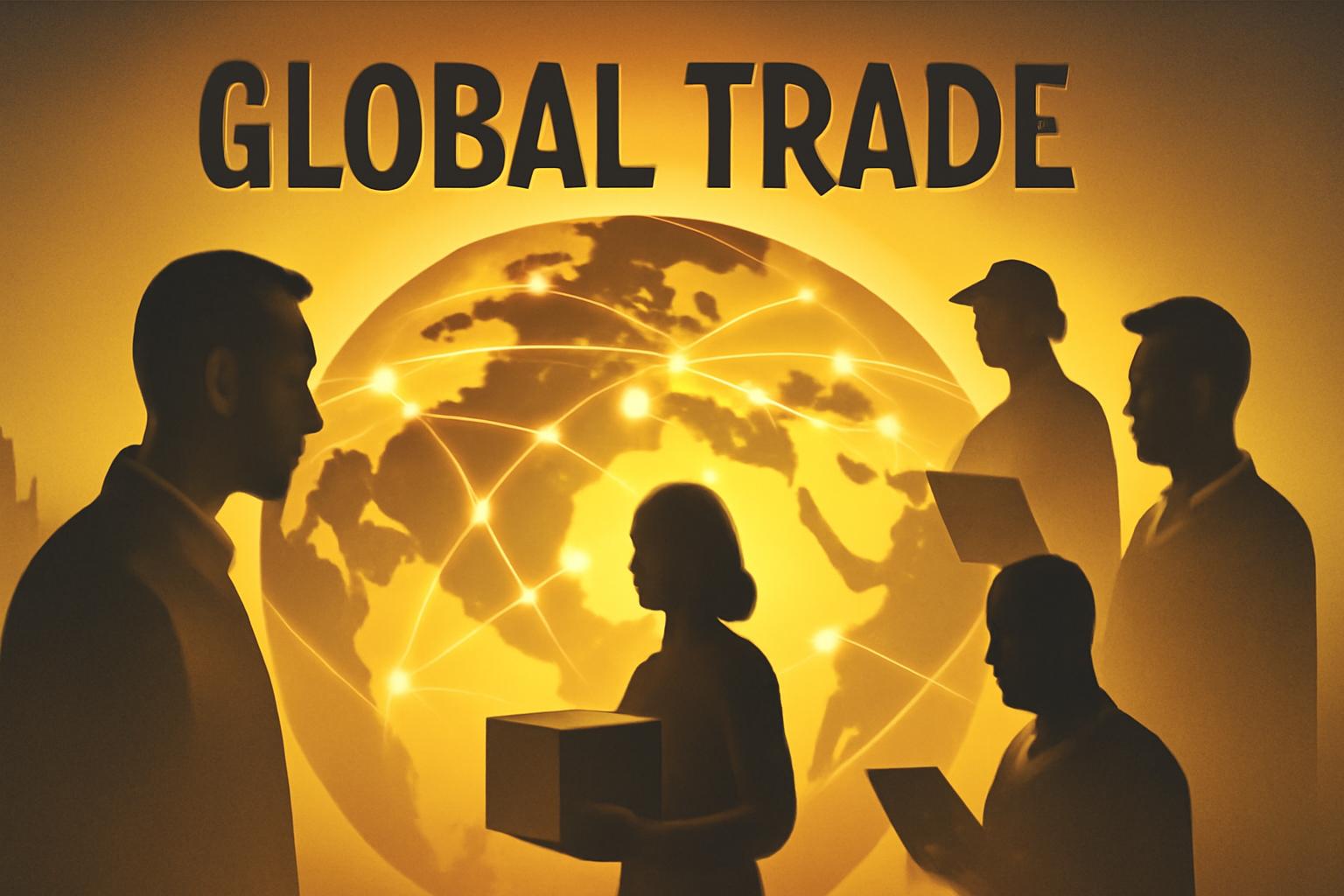The WTO’s assessment highlights the resilience of the global trade system despite unprecedented tariff disruptions. The upcoming U.S.-China negotiations represent a critical inflection point that could either ease tensions or deepen fragmentation risks. !-- wp:paragraph -->
- Opportunities: Potential de-escalation of U.S.-China tariffs could restore growth momentum and reduce market volatility.
- Risks: Prolonged trade disputes risk fracturing the global trade system, disproportionately harming developing economies.
- Technological drivers: AI-related trade growth presents new avenues for economic expansion and competitive advantage.
- Economic headwinds: A slowing global economy and persistent tariffs may constrain trade growth beyond 2025.
FinOracleAI — Market View
The WTO’s assessment highlights the resilience of the global trade system despite unprecedented tariff disruptions. The upcoming U.S.-China negotiations represent a critical inflection point that could either ease tensions or deepen fragmentation risks. !-- wp:paragraph -->- Opportunities: Potential de-escalation of U.S.-China tariffs could restore growth momentum and reduce market volatility.
- Risks: Prolonged trade disputes risk fracturing the global trade system, disproportionately harming developing economies.
- Technological drivers: AI-related trade growth presents new avenues for economic expansion and competitive advantage.
- Economic headwinds: A slowing global economy and persistent tariffs may constrain trade growth beyond 2025.
- Asia accounted for nearly two-thirds of global AI-related trade growth.
- The United States contributed approximately 20% of this AI-related trade expansion.
- Competitive dynamics in AI technology development are intensifying worldwide.
FinOracleAI — Market View
The WTO’s assessment highlights the resilience of the global trade system despite unprecedented tariff disruptions. The upcoming U.S.-China negotiations represent a critical inflection point that could either ease tensions or deepen fragmentation risks. !-- wp:paragraph -->- Opportunities: Potential de-escalation of U.S.-China tariffs could restore growth momentum and reduce market volatility.
- Risks: Prolonged trade disputes risk fracturing the global trade system, disproportionately harming developing economies.
- Technological drivers: AI-related trade growth presents new avenues for economic expansion and competitive advantage.
- Economic headwinds: A slowing global economy and persistent tariffs may constrain trade growth beyond 2025.
Artificial Intelligence Fuels Trade Expansion
A significant driver behind the recent surge in trade has been the growing demand for artificial intelligence (AI)-related goods, including semiconductors, servers, and telecommunications equipment. The WTO highlighted that nearly half of the trade volume increase in the first half of 2025 stemmed from AI-related products, which rose 20% in value year-over-year. !-- wp:paragraph -->- Asia accounted for nearly two-thirds of global AI-related trade growth.
- The United States contributed approximately 20% of this AI-related trade expansion.
- Competitive dynamics in AI technology development are intensifying worldwide.
FinOracleAI — Market View
The WTO’s assessment highlights the resilience of the global trade system despite unprecedented tariff disruptions. The upcoming U.S.-China negotiations represent a critical inflection point that could either ease tensions or deepen fragmentation risks. !-- wp:paragraph -->- Opportunities: Potential de-escalation of U.S.-China tariffs could restore growth momentum and reduce market volatility.
- Risks: Prolonged trade disputes risk fracturing the global trade system, disproportionately harming developing economies.
- Technological drivers: AI-related trade growth presents new avenues for economic expansion and competitive advantage.
- Economic headwinds: A slowing global economy and persistent tariffs may constrain trade growth beyond 2025.
- Global trade volumes surged 4.9% year-on-year in the first half of 2025.
- Import front-loading ahead of tariff hikes contributed substantially to early growth.
- Favorable macroeconomic factors such as disinflation and strong labor markets supported spending.
Artificial Intelligence Fuels Trade Expansion
A significant driver behind the recent surge in trade has been the growing demand for artificial intelligence (AI)-related goods, including semiconductors, servers, and telecommunications equipment. The WTO highlighted that nearly half of the trade volume increase in the first half of 2025 stemmed from AI-related products, which rose 20% in value year-over-year. !-- wp:paragraph -->- Asia accounted for nearly two-thirds of global AI-related trade growth.
- The United States contributed approximately 20% of this AI-related trade expansion.
- Competitive dynamics in AI technology development are intensifying worldwide.
FinOracleAI — Market View
The WTO’s assessment highlights the resilience of the global trade system despite unprecedented tariff disruptions. The upcoming U.S.-China negotiations represent a critical inflection point that could either ease tensions or deepen fragmentation risks. !-- wp:paragraph -->- Opportunities: Potential de-escalation of U.S.-China tariffs could restore growth momentum and reduce market volatility.
- Risks: Prolonged trade disputes risk fracturing the global trade system, disproportionately harming developing economies.
- Technological drivers: AI-related trade growth presents new avenues for economic expansion and competitive advantage.
- Economic headwinds: A slowing global economy and persistent tariffs may constrain trade growth beyond 2025.
“Any threat of fragmentation or division between the two, into two global trading camps, will lead to losses in global welfare, and the poorer countries will be harder hit.”
— Ngozi Okonjo-IwealaWTO Revises Trade Growth Outlook Amid Economic Headwinds
In October 2025, the WTO updated its global trade volume forecasts, reflecting a mixed outlook. The organization raised its 2025 trade growth projection sharply from 0.9% to 2.4%, driven by robust activity in the year’s first half. However, it simultaneously downgraded the 2026 forecast from 1.8% to a modest 0.5%, citing a cooling global economy and tariff pressures. !-- wp:paragraph -->- Global trade volumes surged 4.9% year-on-year in the first half of 2025.
- Import front-loading ahead of tariff hikes contributed substantially to early growth.
- Favorable macroeconomic factors such as disinflation and strong labor markets supported spending.
Artificial Intelligence Fuels Trade Expansion
A significant driver behind the recent surge in trade has been the growing demand for artificial intelligence (AI)-related goods, including semiconductors, servers, and telecommunications equipment. The WTO highlighted that nearly half of the trade volume increase in the first half of 2025 stemmed from AI-related products, which rose 20% in value year-over-year. !-- wp:paragraph -->- Asia accounted for nearly two-thirds of global AI-related trade growth.
- The United States contributed approximately 20% of this AI-related trade expansion.
- Competitive dynamics in AI technology development are intensifying worldwide.
FinOracleAI — Market View
The WTO’s assessment highlights the resilience of the global trade system despite unprecedented tariff disruptions. The upcoming U.S.-China negotiations represent a critical inflection point that could either ease tensions or deepen fragmentation risks. !-- wp:paragraph -->- Opportunities: Potential de-escalation of U.S.-China tariffs could restore growth momentum and reduce market volatility.
- Risks: Prolonged trade disputes risk fracturing the global trade system, disproportionately harming developing economies.
- Technological drivers: AI-related trade growth presents new avenues for economic expansion and competitive advantage.
- Economic headwinds: A slowing global economy and persistent tariffs may constrain trade growth beyond 2025.
“Any threat of fragmentation or division between the two, into two global trading camps, will lead to losses in global welfare, and the poorer countries will be harder hit.”
— Ngozi Okonjo-IwealaWTO Revises Trade Growth Outlook Amid Economic Headwinds
In October 2025, the WTO updated its global trade volume forecasts, reflecting a mixed outlook. The organization raised its 2025 trade growth projection sharply from 0.9% to 2.4%, driven by robust activity in the year’s first half. However, it simultaneously downgraded the 2026 forecast from 1.8% to a modest 0.5%, citing a cooling global economy and tariff pressures. !-- wp:paragraph -->- Global trade volumes surged 4.9% year-on-year in the first half of 2025.
- Import front-loading ahead of tariff hikes contributed substantially to early growth.
- Favorable macroeconomic factors such as disinflation and strong labor markets supported spending.
Artificial Intelligence Fuels Trade Expansion
A significant driver behind the recent surge in trade has been the growing demand for artificial intelligence (AI)-related goods, including semiconductors, servers, and telecommunications equipment. The WTO highlighted that nearly half of the trade volume increase in the first half of 2025 stemmed from AI-related products, which rose 20% in value year-over-year. !-- wp:paragraph -->- Asia accounted for nearly two-thirds of global AI-related trade growth.
- The United States contributed approximately 20% of this AI-related trade expansion.
- Competitive dynamics in AI technology development are intensifying worldwide.
FinOracleAI — Market View
The WTO’s assessment highlights the resilience of the global trade system despite unprecedented tariff disruptions. The upcoming U.S.-China negotiations represent a critical inflection point that could either ease tensions or deepen fragmentation risks. !-- wp:paragraph -->- Opportunities: Potential de-escalation of U.S.-China tariffs could restore growth momentum and reduce market volatility.
- Risks: Prolonged trade disputes risk fracturing the global trade system, disproportionately harming developing economies.
- Technological drivers: AI-related trade growth presents new avenues for economic expansion and competitive advantage.
- Economic headwinds: A slowing global economy and persistent tariffs may constrain trade growth beyond 2025.
U.S.-China Trade Negotiations: A Critical Juncture
The spotlight remains on the upcoming meeting between U.S. President Donald Trump and Chinese President Xi Jinping, anticipated to be a pivotal moment for resolving tariff disputes. Trump’s ongoing Asia tour has included trade agreements and temporary truces, but the core challenge lies in reaching a comprehensive deal to reduce mutual duties and counter-tariffs. !-- wp:paragraph --> Okonjo-Iweala emphasized the global ramifications of a potential trade truce, stating that any escalation or division between the two economic giants would harm not only their own economies but also the global trading system, disproportionately affecting poorer nations. !-- wp:paragraph -->“Any threat of fragmentation or division between the two, into two global trading camps, will lead to losses in global welfare, and the poorer countries will be harder hit.”
— Ngozi Okonjo-IwealaWTO Revises Trade Growth Outlook Amid Economic Headwinds
In October 2025, the WTO updated its global trade volume forecasts, reflecting a mixed outlook. The organization raised its 2025 trade growth projection sharply from 0.9% to 2.4%, driven by robust activity in the year’s first half. However, it simultaneously downgraded the 2026 forecast from 1.8% to a modest 0.5%, citing a cooling global economy and tariff pressures. !-- wp:paragraph -->- Global trade volumes surged 4.9% year-on-year in the first half of 2025.
- Import front-loading ahead of tariff hikes contributed substantially to early growth.
- Favorable macroeconomic factors such as disinflation and strong labor markets supported spending.
Artificial Intelligence Fuels Trade Expansion
A significant driver behind the recent surge in trade has been the growing demand for artificial intelligence (AI)-related goods, including semiconductors, servers, and telecommunications equipment. The WTO highlighted that nearly half of the trade volume increase in the first half of 2025 stemmed from AI-related products, which rose 20% in value year-over-year. !-- wp:paragraph -->- Asia accounted for nearly two-thirds of global AI-related trade growth.
- The United States contributed approximately 20% of this AI-related trade expansion.
- Competitive dynamics in AI technology development are intensifying worldwide.
FinOracleAI — Market View
The WTO’s assessment highlights the resilience of the global trade system despite unprecedented tariff disruptions. The upcoming U.S.-China negotiations represent a critical inflection point that could either ease tensions or deepen fragmentation risks. !-- wp:paragraph -->- Opportunities: Potential de-escalation of U.S.-China tariffs could restore growth momentum and reduce market volatility.
- Risks: Prolonged trade disputes risk fracturing the global trade system, disproportionately harming developing economies.
- Technological drivers: AI-related trade growth presents new avenues for economic expansion and competitive advantage.
- Economic headwinds: A slowing global economy and persistent tariffs may constrain trade growth beyond 2025.
“The system is battered, it’s bruised, but it’s still standing,”
— Ngozi Okonjo-Iweala, WTO Director-GeneralU.S.-China Trade Negotiations: A Critical Juncture
The spotlight remains on the upcoming meeting between U.S. President Donald Trump and Chinese President Xi Jinping, anticipated to be a pivotal moment for resolving tariff disputes. Trump’s ongoing Asia tour has included trade agreements and temporary truces, but the core challenge lies in reaching a comprehensive deal to reduce mutual duties and counter-tariffs. !-- wp:paragraph --> Okonjo-Iweala emphasized the global ramifications of a potential trade truce, stating that any escalation or division between the two economic giants would harm not only their own economies but also the global trading system, disproportionately affecting poorer nations. !-- wp:paragraph -->“Any threat of fragmentation or division between the two, into two global trading camps, will lead to losses in global welfare, and the poorer countries will be harder hit.”
— Ngozi Okonjo-IwealaWTO Revises Trade Growth Outlook Amid Economic Headwinds
In October 2025, the WTO updated its global trade volume forecasts, reflecting a mixed outlook. The organization raised its 2025 trade growth projection sharply from 0.9% to 2.4%, driven by robust activity in the year’s first half. However, it simultaneously downgraded the 2026 forecast from 1.8% to a modest 0.5%, citing a cooling global economy and tariff pressures. !-- wp:paragraph -->- Global trade volumes surged 4.9% year-on-year in the first half of 2025.
- Import front-loading ahead of tariff hikes contributed substantially to early growth.
- Favorable macroeconomic factors such as disinflation and strong labor markets supported spending.
Artificial Intelligence Fuels Trade Expansion
A significant driver behind the recent surge in trade has been the growing demand for artificial intelligence (AI)-related goods, including semiconductors, servers, and telecommunications equipment. The WTO highlighted that nearly half of the trade volume increase in the first half of 2025 stemmed from AI-related products, which rose 20% in value year-over-year. !-- wp:paragraph -->- Asia accounted for nearly two-thirds of global AI-related trade growth.
- The United States contributed approximately 20% of this AI-related trade expansion.
- Competitive dynamics in AI technology development are intensifying worldwide.
FinOracleAI — Market View
The WTO’s assessment highlights the resilience of the global trade system despite unprecedented tariff disruptions. The upcoming U.S.-China negotiations represent a critical inflection point that could either ease tensions or deepen fragmentation risks. !-- wp:paragraph -->- Opportunities: Potential de-escalation of U.S.-China tariffs could restore growth momentum and reduce market volatility.
- Risks: Prolonged trade disputes risk fracturing the global trade system, disproportionately harming developing economies.
- Technological drivers: AI-related trade growth presents new avenues for economic expansion and competitive advantage.
- Economic headwinds: A slowing global economy and persistent tariffs may constrain trade growth beyond 2025.
WTO Chief: Global Trade Resilient Despite Tariff Disruptions
The World Trade Organization (WTO) reaffirmed the endurance of the global trade system amid significant disruptions caused by the United States’ tariff regime in 2025. WTO Director-General Ngozi Okonjo-Iweala acknowledged that while the unilateral U.S. tariffs have created the most substantial disruption in global trade in over eight decades, the system remains intact. !-- wp:paragraph -->“The system is battered, it’s bruised, but it’s still standing,”
— Ngozi Okonjo-Iweala, WTO Director-GeneralU.S.-China Trade Negotiations: A Critical Juncture
The spotlight remains on the upcoming meeting between U.S. President Donald Trump and Chinese President Xi Jinping, anticipated to be a pivotal moment for resolving tariff disputes. Trump’s ongoing Asia tour has included trade agreements and temporary truces, but the core challenge lies in reaching a comprehensive deal to reduce mutual duties and counter-tariffs. !-- wp:paragraph --> Okonjo-Iweala emphasized the global ramifications of a potential trade truce, stating that any escalation or division between the two economic giants would harm not only their own economies but also the global trading system, disproportionately affecting poorer nations. !-- wp:paragraph -->“Any threat of fragmentation or division between the two, into two global trading camps, will lead to losses in global welfare, and the poorer countries will be harder hit.”
— Ngozi Okonjo-IwealaWTO Revises Trade Growth Outlook Amid Economic Headwinds
In October 2025, the WTO updated its global trade volume forecasts, reflecting a mixed outlook. The organization raised its 2025 trade growth projection sharply from 0.9% to 2.4%, driven by robust activity in the year’s first half. However, it simultaneously downgraded the 2026 forecast from 1.8% to a modest 0.5%, citing a cooling global economy and tariff pressures. !-- wp:paragraph -->- Global trade volumes surged 4.9% year-on-year in the first half of 2025.
- Import front-loading ahead of tariff hikes contributed substantially to early growth.
- Favorable macroeconomic factors such as disinflation and strong labor markets supported spending.
Artificial Intelligence Fuels Trade Expansion
A significant driver behind the recent surge in trade has been the growing demand for artificial intelligence (AI)-related goods, including semiconductors, servers, and telecommunications equipment. The WTO highlighted that nearly half of the trade volume increase in the first half of 2025 stemmed from AI-related products, which rose 20% in value year-over-year. !-- wp:paragraph -->- Asia accounted for nearly two-thirds of global AI-related trade growth.
- The United States contributed approximately 20% of this AI-related trade expansion.
- Competitive dynamics in AI technology development are intensifying worldwide.
FinOracleAI — Market View
The WTO’s assessment highlights the resilience of the global trade system despite unprecedented tariff disruptions. The upcoming U.S.-China negotiations represent a critical inflection point that could either ease tensions or deepen fragmentation risks. !-- wp:paragraph -->- Opportunities: Potential de-escalation of U.S.-China tariffs could restore growth momentum and reduce market volatility.
- Risks: Prolonged trade disputes risk fracturing the global trade system, disproportionately harming developing economies.
- Technological drivers: AI-related trade growth presents new avenues for economic expansion and competitive advantage.
- Economic headwinds: A slowing global economy and persistent tariffs may constrain trade growth beyond 2025.













